In the serene world of Japanese interiors,where minimalism dances gracefully with nature,the incorporation of natural stone accents elevates the aesthetic experience to new heights. Imagine stepping into a living room that exudes tranquility, where the warmth of wood meets the rugged elegance of stone. These tactile elements not only serve as functional art but also connect us to the earth, grounding our spaces in authenticity.in this exploration of “Harmony in Design,” we delve into the harmonious marriage of natural stone within Japanese living rooms, uncovering how these timeless materials enhance both the beauty and spirit of the home. Join us as we journey through the beliefs of simplicity and the art of balance, celebrating the way stone can transform living spaces into sanctuaries of peace and contemplation.
Natural Beauty: The Allure of Japanese Aesthetics in Stone Accents
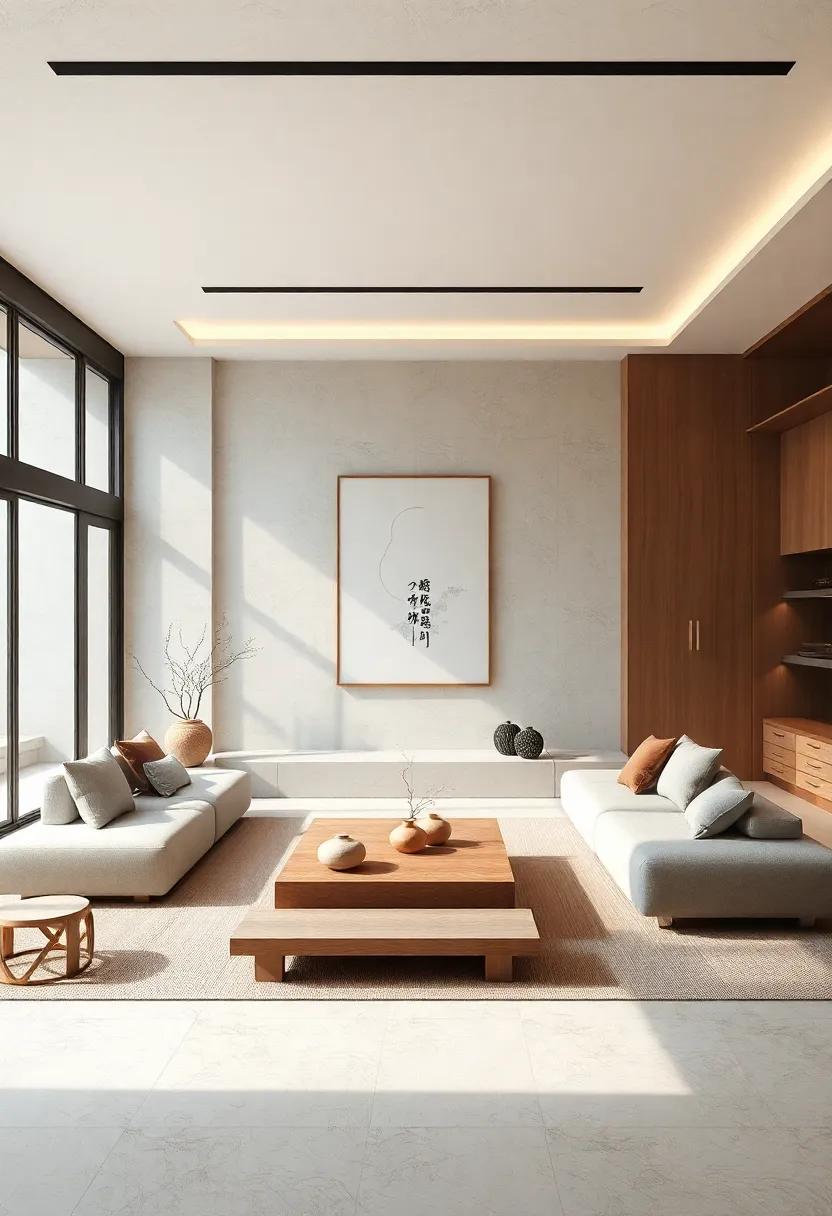
Japanese aesthetics embrace the beauty of simplicity and nature, frequently enough reflected in their choice of materials and design elements. Stone accents play a pivotal role in this philosophy, bringing a touch of the natural world indoors. By incorporating various types of stones, such as granite, marble, or slate, a living room can be transformed into a tranquil oasis that promotes mindfulness and contemplation. The texture and color variations found in natural stone evoke the changing seasons, allowing homeowners to experience nature’s beauty throughout the year, without stepping outside.
In Japanese design, the harmonious blend of stone with other elements is paramount.Stone can be used in various applications, enhancing both visual and tactile experiences. Consider implementing stone features such as:
- Accent walls that create a calming backdrop.
- Fireplaces encased in rich, textured stone for a warm gathering space.
- Tabletops that invite nature’s beauty into everyday life.
This seamless integration results in a living space that celebrates nature, fosters tranquility, and encourages a deep gratitude for the small details that enhance daily experiences.
Serenity in Texture: The Unmatched Feel of Natural Stone in Living Spaces

The tactile experience of natural stone elevates the design of living spaces, bringing an irreplaceable touch of authenticity that complements the minimalist aesthetic typical of Japanese interiors. From smooth marble to rough-hewn granite, each stone type introduces a unique sensory element that enhances the overall ambiance. Incorporating these materials can transform subtle corners into inviting retreats, offering a juxtaposition of the organic and conventional. With textures that invite touch, the varying finishes foster a sense of connectedness to nature, perfectly aligning with the Japanese philosophy of harmony and balance in living environments.
Key aspects of utilizing natural stone in interior design include its durability, versatility, and timeless beauty. The following attributes make it an outstanding choice for any Japanese living room:
- Breathability: Natural stone helps maintain optimal humidity levels.
- Color Variance: Each piece tells a story through its unique hues and patterns.
- Low Maintainance: Resilient against stains and everyday wear, requiring little upkeep.
Earthy Tones: Enhancing Ambiance with Subtle Color Schemes

Incorporating earthy tones into a design elevates the overall atmosphere, creating a serene and inviting space reminiscent of nature. When paired with natural stone accents,such as granite or slate,these colors invoke feelings of calm and tranquility. Opt for shades like terracotta, muted greens, and soft browns to harmonize with the rich textures of stone. Bringing in textured textiles, such as wool or linen, in complementary hues not only enhances visual interest but also softens the interplay between stone and fabric, ensuring a cohesive look.
To fully embrace this color palette, consider the following elements:
- Accent Walls: Paint one wall in an earthy hue to create a focal point.
- Textured Rugs: Add a natural fiber rug to tie the space together.
- Plant Life: Introduce greenery, such as bonsai trees or ferns, to breathe life into the room.
| Color | Effect |
|---|---|
| Terracotta | Warmth and grounding |
| muted Green | Restfulness and nature |
| Soft Brown | Stability and comfort |
Harmonious Balance: Integrating Stone with Traditional Wood Elements
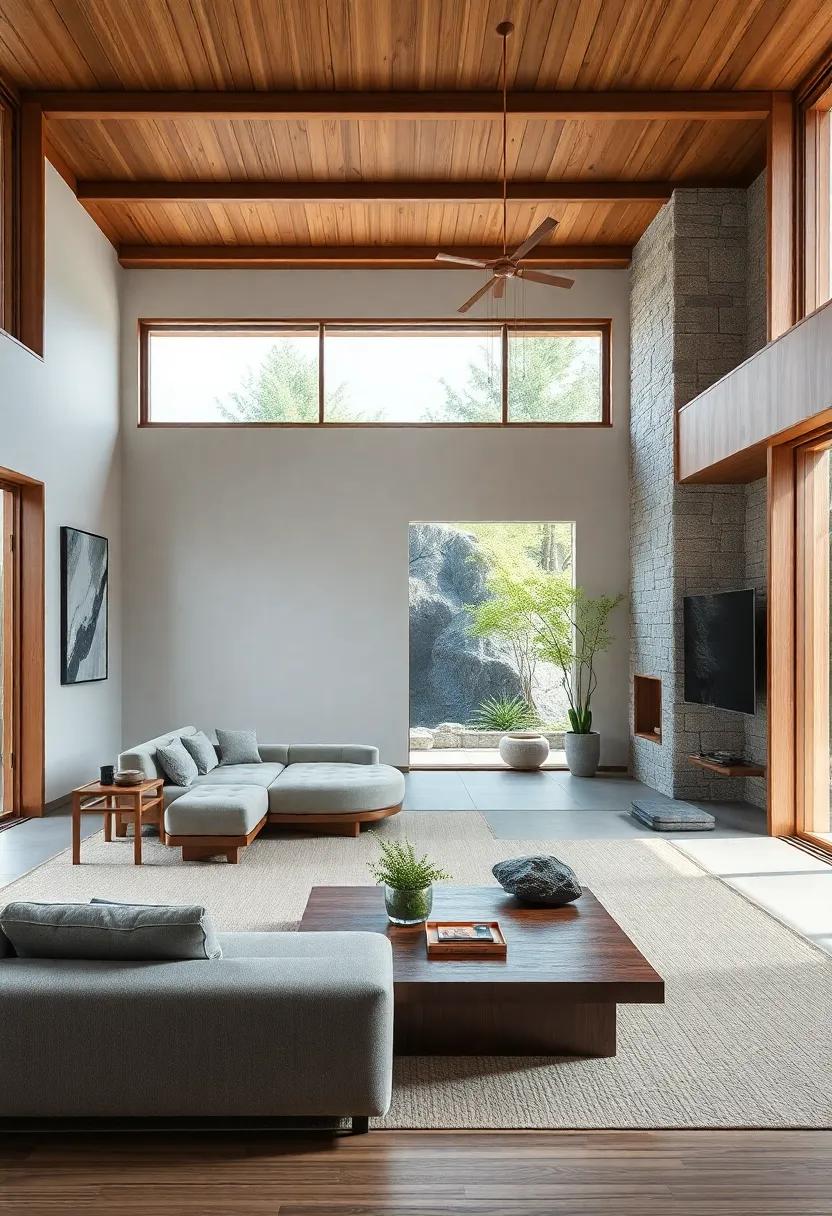
Integrating stone into a traditional wooden aesthetic can elevate the serene atmosphere of a Japanese living room, allowing for a visual dialog between the organic warmth of wood and the cool elegance of natural stone. Granite, slate, and river stones can be utilized in various decor elements, such as accent walls, fireplaces, or even as part of the flooring. Consider the following combinations:
- Wooden Beams with Slate Tile: Harmoniously blending the rustic appeal of exposed beams with the sleek finish of slate tiles creates a space that feels both grounded and contemporary.
- Natural Stone Flooring with Wooden Accents: A foundation of flagstone or polished pebbles paired with wooden furniture can evoke a tranquil garden-like ambiance indoors.
- Stone Planters with Wooden Shelving: Incorporating stone planters on natural wood shelves brings a touch of nature closer within reach, emphasizing the connection between the indoor and outdoor environments.
Balance can also be achieved through thoughtful arrangement of stone and wood items to create focal points that invite serenity and reflection.To enhance this aesthetic further, consider these design tips:
| Description | Effect |
|---|---|
| Use Layering | Softens the transition between different materials, adding depth. |
| Create Contrast | enhances visual appeal through opposing textures and colors. |
| Incorporate Natural Light | Highlights the uniqueness of stone finishes, enhancing their beauty. |
Fluid Lines: The Importance of Smooth Edges in Design Harmony
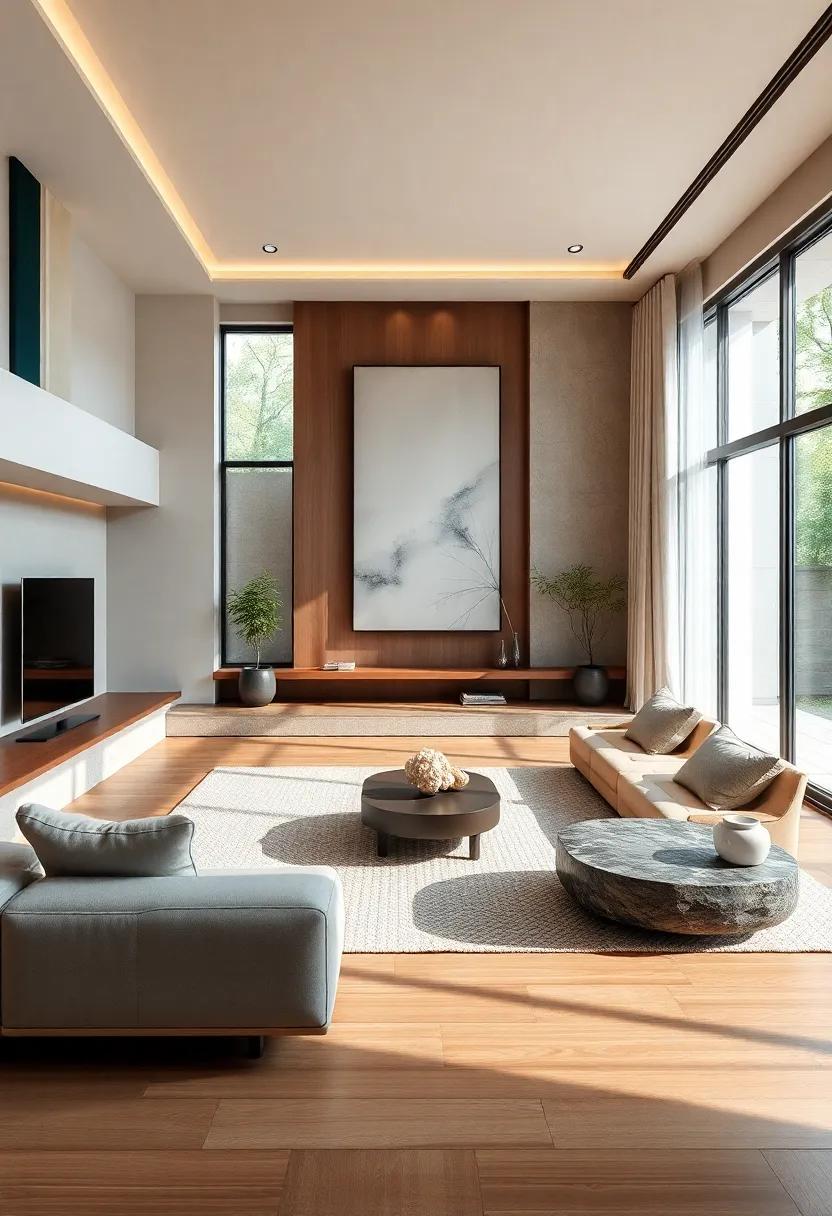
Incorporating smooth, fluid lines within a space directs the eye effortlessly along surfaces and shapes, establishing a calming flow that complements the tranquil ethos of Japanese interior design. Natural stone accents, with their organic curves and polished edges, play a pivotal role in this aesthetic by enhancing the visual rhythm of the room. They create a seamless connection between elements, imparting a sense of unity. Key advantages include:
- Balance: Soft edges help in distributing visual weight, making spaces feel more inviting.
- warmth: Natural materials exude a sense of coziness, contrasting with hard, angular features.
- Emphasis on Nature: The irregularities and textures of stone remind us of the natural world, fostering a sense of peace.
When strategically placed, these elements not only enhance aesthetics but can also influence mood and functionality within living spaces. For instance, a gently rounded stone coffee table can become a focal point, drawing people together and encouraging interaction. by embracing these organic forms, the design achieves a tranquil yet engaging atmosphere.Below are examples of stone accents that can enrich your living room:
| Stone Type | Texture | Ideal Placement |
|---|---|---|
| Marble | Smooth and polished | Tabletops, flooring |
| Slate | Textured and natural | accent walls, decorative elements |
| Limestone | Earthy and warm | Fireplaces, sculptures |
Zen Inspirations: Creating Tranquility with Natural Stone Details

Natural stone details can serve as majestic focal points in a Japanese living room, inviting an atmosphere of serenity and balance. Incorporating materials such as granite, marble, or slate can enhance the visual warmth and tactile experience of the space, ensuring that each element resonates with nature. Consider introducing a stone accent wall or a minimalist stone hearth to create a grounding effect. Furthermore, harmoniously pairing these elements with wooden accents can amplify the organic feel, blurring the boundaries between the indoor and outdoor environments.
To maximize the tranquility inspired by natural stone, select pieces that speak to the ethos of simplicity and mindfulness. Here are some ideas to explore:
- stone Planters: integrate potted plants in gorgeous stone containers for an earthy vibe.
- Tabletops: Use polished stone surfaces for coffee tables that encourage gatherings.
- Zen Gardens: A mini stone garden can serve as a meditative focal point.
- Wall Art: unique stone sculptures can bring an artistic touch.
| Stone Type | Characteristic | Best Use |
|---|---|---|
| Granite | Durable and elegant | Countertops, Tables |
| Marble | Luxurious and smooth | Accent Pieces |
| Slate | Textured and natural | Walls, Floorings |
Cultural Significance: The Role of Stone in Japanese Design Philosophy

In Japanese design philosophy, stone transcends its physical properties to become a symbol of nature’s enduring beauty and resilience. Its use in living spaces embodies the core tenets of wabi-sabi, which celebrates imperfection and the natural cycle of growth and decay. Stones,whether in their natural form as polished pebbles,slate tiles,or sculpted features,evoke a sense of tranquility and rootedness. by integrating stone into living room designs, homeowners can create an atmosphere that fosters serenity and mindfulness, allowing each space to tell a unique story that resonates with simplicity and authenticity.
Moreover,stone accents serve to harmonize the indoor environment with the surrounding landscape,blurring the boundaries between nature and architecture. The selection of stone elements,such as granite,sugi (Japanese cedar),or river stones,can influence the overall mood of the space.Consider incorporating elements such as:
- Feature walls that bring the beauty of the outdoors inside
- Stone planters that seamlessly meld nature with decor
- Custom stone tables that serve as functional art pieces
Such choices reflect an appreciation for craftsmanship and a commitment to sustainability, emphasizing the cultural significance of materials that have been respected and utilized for centuries. By embracing stone in design, one not only enhances the aesthetic appeal of their living room but also pays homage to the rich heritage and principles that define Japanese aesthetics.
Craftsmanship: The Art of Selecting Handmade Stone Features

When considering handmade stone features for a Japanese living room, the emphasis lies on authenticity and artistry. Each piece carries with it the unique imprint of the craftsman, celebrating the beauty of natural imperfections and textures. Selecting the right stone accents requires a discerning eye; one must appreciate the variations in color, pattern, and finish that are inherent to natural materials.Vital factors to consider include:
- Material Type: Whether it’s a warm, earthy granite or a cool, tranquil slate, understanding the properties of different stones is essential.
- Finish: The choice between polished or raw can dramatically alter the aesthetic and tactile experience of your space.
- Provenance: Stones sourced locally frequently enough carry cultural significance and resonate deeply within Japanese design philosophies.
The process of choosing handmade stone elements involves not just visual appeal,but also a thoughtful consideration of how these pieces will interact with light,scale,and overall ambiance.It’s vital to envision how stone features will harmonize with other design aspects, such as tatami mats, shoji screens, and wooden elements found in traditional Japanese interiors. Incorporating stone can enhance an environment by introducing a sense of calm and groundedness; here’s a quick overview of popular stone features used in Japanese living rooms:
| Stone Feature | Purpose | Design Benefit |
|---|---|---|
| Shishi-odoshi | Water feature | Adds tranquility and a rhythmic sound element |
| Interior Stone Wall | Visual anchor | Creates depth and textural contrast |
| Stone Hearth | Focus point | Warmth and a gathering place |
Elemental Fusion: Combining Metal and Stone for Modern Appeal

In recent design trends, the combination of metal and stone has emerged as a captivating dialogue between the durability of the former and the organic charm of the latter. Japanese living rooms are increasingly embracing this fusion,where the clean lines and sleek finishes of metal juxtapose beautifully with the textured surfaces of natural stone. By integrating elements like brushed steel or copper accents with traditional stone features, homeowners can create a balanced aesthetic that resonates with modern elegance. This synergy not only enhances visual appeal but also embodies the essence of Zen, promoting tranquility and harmony within the space.
To achieve this balance, consider incorporating key elements that highlight both materials. Examples include:
- Metal frames supporting stone tabletops or shelves
- Stone accent walls featuring metal artwork or fixtures
- Mixed-material furnishings that blend metal legs with stone surfaces
Such thoughtful pairings not only cultivate visual interest but also invite tactile engagement, enriching the sensory experience of the living environment. The subtle interplay of textures can result in inviting spaces that resonate with both modern aesthetics and traditional craftsmanship.
Light and Shadow: The play of Natural Light on Stone Surfaces

The interplay of light and shadow reveals the inherent beauty of natural stone, enhancing its texture and color in a living space. When sunlight streams through shoji screens or window openings, it dances across stone surfaces, creating a dynamic visual experience that changes throughout the day. Granite, with its speckled patterns, and marble, with its soft veining, exhibit a unique character as daylight passes over them, illuminating their properties. This change can evoke feelings of tranquility and harmony, inviting residents to pause and appreciate the artistry of nature crafted in stone.
Homeowners often select stone elements not just for their durability but also for how they manipulate the ambiance of a room.Key aspects to consider include:
- Surface Finish: Polished surfaces reflect light beautifully, while honed finishes offer a more muted, subtle glow.
- Stone Color: Lighter stones can brighten a space, while darker tones create depth and warmth.
- Placement: Strategically positioning stone accents can maximize daylight, enhancing the overall mood of the living room.
To illustrate this concept, here’s a comparison of different stone finishes and their effects on light:
| stone Finish | Light Reflection | Aesthetic Effect |
|---|---|---|
| Polished | High | Shiny, reflective |
| Honed | Medium | Soft, Matte |
| Textured | Low | Natural, Rustic |
Natural Patterns: Embracing Unique Veins and Textures of Stones
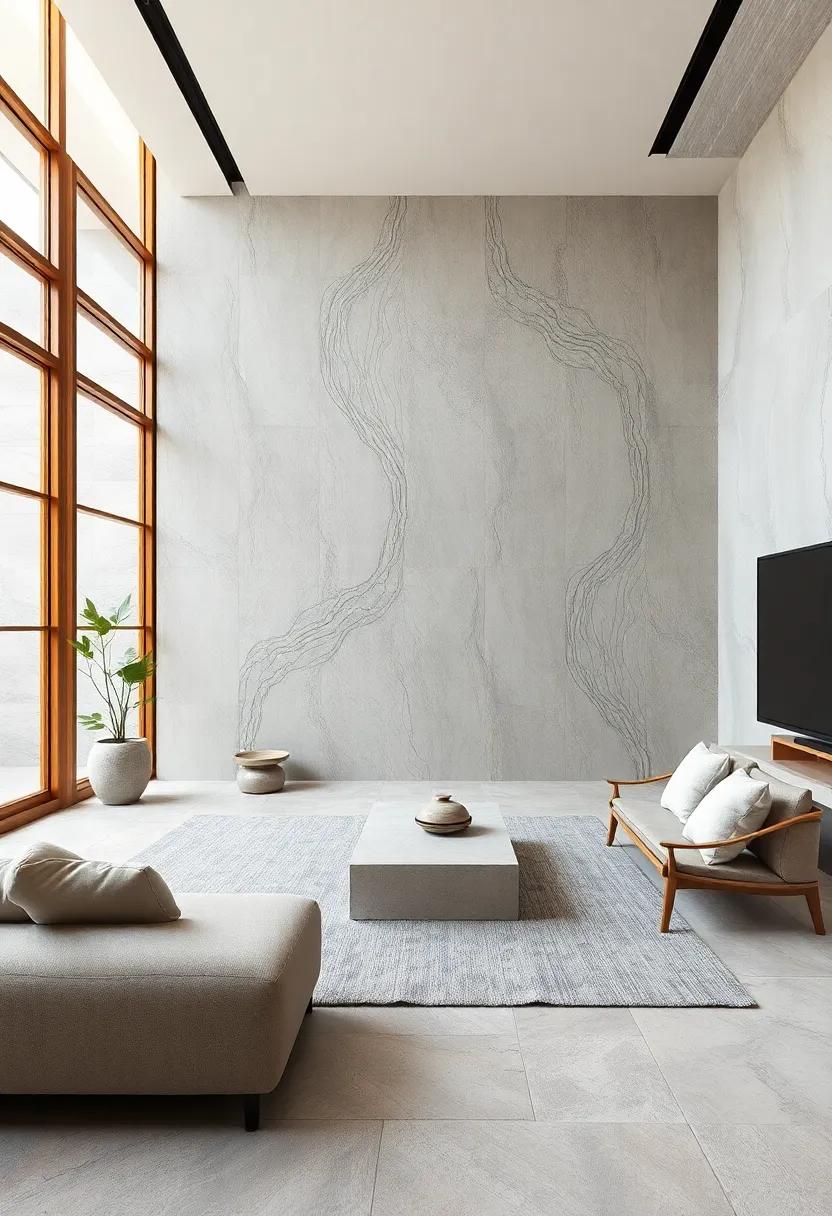
Natural stones possess a captivating beauty that is often characterized by their unique veins and textures. Each piece tells a story, shaped over millennia through natural processes, and no two stones are alike. This inherent individuality makes them an ideal choice for accentuating any living space, especially in the serene backdrop of a Japanese living room. By incorporating these stones into your design, you celebrate the organic artistry of nature while creating a warm and inviting atmosphere. The fluid lines and distinctive patterns frequently enough evoke a sense of tranquility, allowing for a harmonious connection between the interior and the natural world.
When selecting natural stone elements for your space, consider a range of options that showcase their diverse features. From the rich hues of marbled granite to the delicate swirls of polished soapstone, each selection adds depth and character to the room.Here are some ways to use these captivating materials:
- Accent walls: Create a focal point with stone-clad walls that bring a touch of nature indoors.
- Tabletops: Incorporate stone surfaces in coffee tables or side tables for an elegant touch.
- Shelves: Use stone shelving to display art pieces or plants, adding a layer of texture.
- Fireplace Surrounds: Frame your fireplace with natural stone for a timeless and cozy feel.
To inspire your design choices, consider the following popular natural stones and their distinctive qualities:
| Stone Type | Unique Features |
|---|---|
| Soapstone | Soft, warm texture; often features swirling patterns. |
| Granite | High durability; colorful speckles and veining. |
| Marble | Luxurious feel; dramatic veining and smooth finish. |
| Limestone | Earthy tones; rugged texture ideal for rustic designs. |
indoor Harmony: Blending Stone Accents with Japanese Minimalism

In the realm of interior design, the seamless fusion of natural elements with structured simplicity is an art in itself. the introduction of stone accents into a Japanese-inspired living space enhances the richness of texture while maintaining an aura of tranquility.Imagine a carefully curated selection of smooth river stones or sleek granite forming a minimalist coffee table centerpiece. The stones not only add a tactile dimension but also serve as a reminder of nature’s inherent beauty,promoting a sense of calm and balance within the home environment. When paired with light wood furnishings and subtle earth tones, these accents create a cohesive look that celebrates the essence of Japanese aesthetics.
Another meaningful element is the deliberate use of negative space, which allows the natural beauty of stone to stand out without overwhelming the senses. Positioning a stone sculpture or a simple bucket of stones near a window can cast gentle shadows and emphasize the elegant lines of traditional shoji screens.To anchor the design, consider a feature wall clad in natural stone, which not only draws the eye but also infuses warmth and depth into the room. The combination of texture, form, and light transforms the living space into a serene retreat that resonates with harmony, inviting occupants to pause and appreciate the beauty of simplicity.
Eco-Friendly Choices: Selecting Sustainable Natural Stone Materials
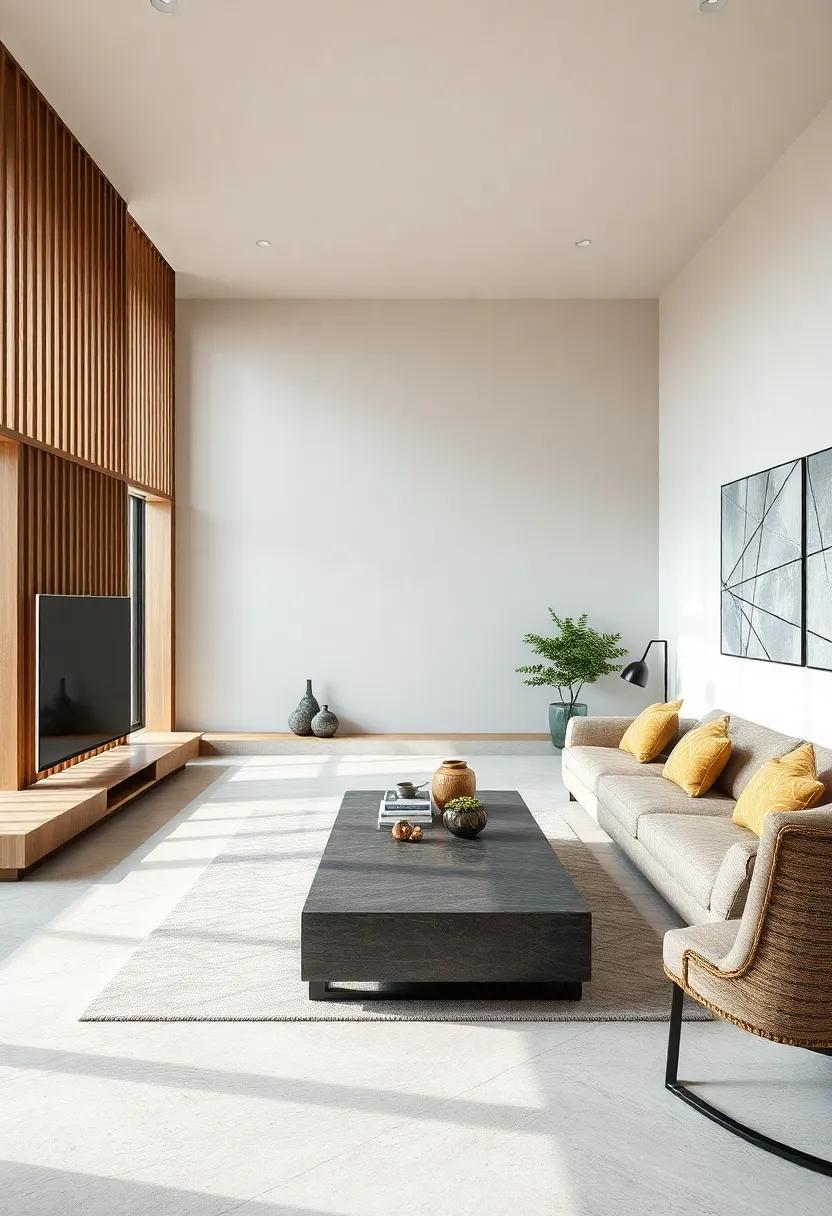
When considering sustainable options for your Japanese living room design, natural stone materials provide a splendid means to marry aesthetics and environmental duty. By choosing stones that are ethically sourced and have minimal environmental impact, homeowners can create a space that not only enhances visual appeal but also promotes a sense of harmony with nature. Look for stones featuring the following qualities to ensure your selection aligns with eco-friendly practices:
- Locally Sourced: Reduces transportation emissions and supports local economies.
- Recyclable: Consider materials that can be repurposed at the end of their life cycle.
- Low VOC Content: Select stones that do not release harmful volatile organic compounds.
Integrating these materials into your design not only reflects your commitment to sustainability but also enhances the overall ambiance of the space. For instance, polished granite or slate can be used for flooring or countertops, while river stones can serve as soothing accents in different corners of the room. The key is to balance your choices, focusing on the elegance and texture of natural stone while ensuring that your materials are sourced responsibly. The table below illustrates some popular sustainable natural stone options and their benefits:
| Stone Type | Benefit |
|---|---|
| Granite | Highly durable and resistant to heat. |
| Slate | Natural slip resistance, ideal for flooring. |
| Limestone | Soft texture, blends well with traditional aesthetics. |
| Marble | Classic elegance,great for accents and decor. |
Versatile Spaces: Using Stone in Both Classic and Contemporary Designs

Natural stone is a remarkable material that effortlessly bridges the gap between traditional and modern aesthetics, allowing for versatile applications in Japanese living rooms. Its unique textures and colors can enhance the serene atmosphere typical of Japanese design,while simultaneously providing a contemporary edge. Consider incorporating granite or slate for an elegant coffee table, or using river stones in a decorative feature, such as a focal wall or fireplace. These choices not only pay homage to natural elements but also add a sophisticated flair that complements a minimalist approach.
When blending stone into your living space, it’s essential to consider its presence in both functional and decorative aspects. Here are a few stunning ideas for your design:
- Accent Walls: Create a stunning feature wall with textured stone that draws the eye.
- Fireplace Surrounds: A marble or slate fireplace can serve as a striking focal point.
- Tabletops: Utilize smooth stone slabs for coffee tables or side tables, marrying function with aesthetic appeal.
Here’s a brief comparison of stone types that suit different styles:
| Stone Type | Classic Aesthetic | Contemporary Aesthetic |
|---|---|---|
| Granite | ✔️ | ✔️ |
| Marble | ✔️ | ✔️ |
| Slate | ✔️ | ✔️ |
| River Stones | ✔️ | ❌ |
Color Symbiosis: Tying Stone Accents into Your color Palette
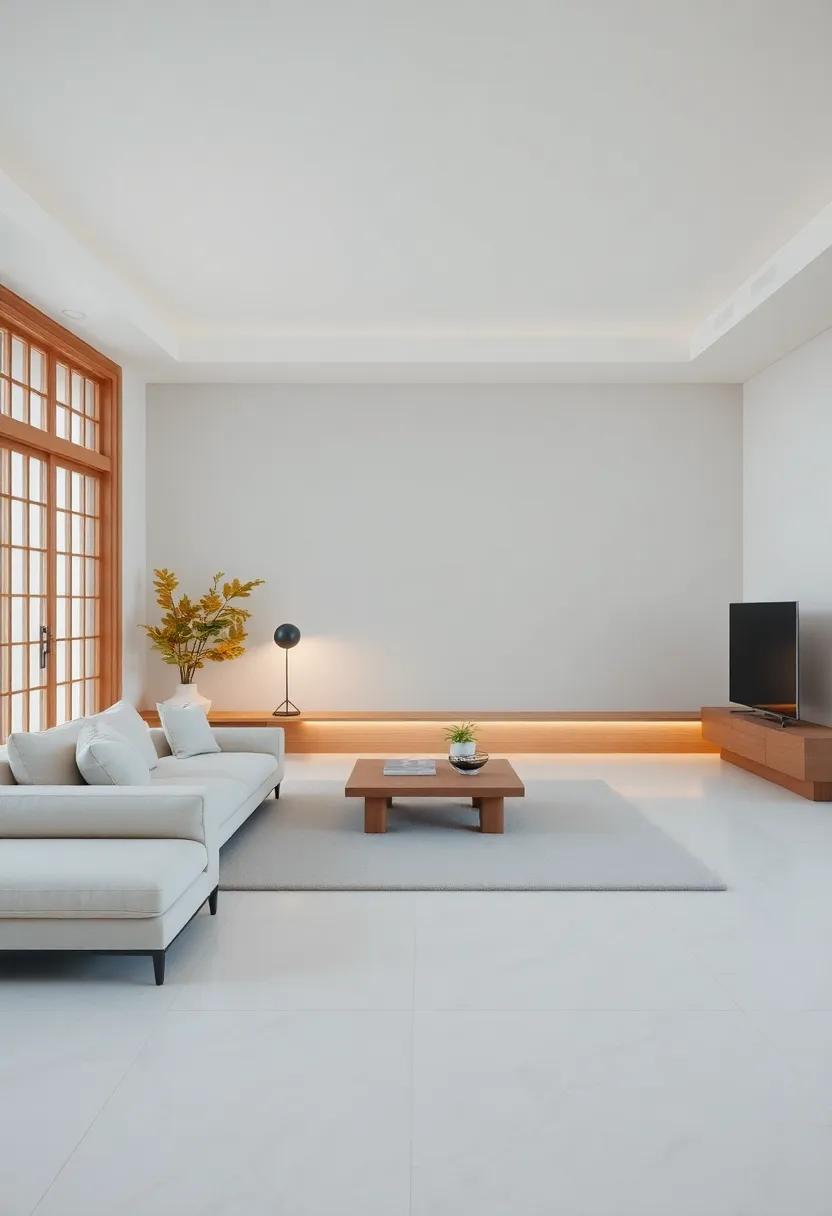
Integrating natural stone accents into your color palette creates a engaging interplay between raw textures and soft hues. Start by selecting a primary color scheme, then choose stone elements that complement rather than compete with your existing colors. Common options include:
- Warm beige or taupe stones paired with earthy greens and soft creams
- Cool gray stones harmonizing with deep blues and crisp whites
- Rustic brown stones mixing beautifully with burnt oranges and muted yellows
To ensure a cohesive look, it’s crucial to consider the undertones of the stone you choose. A well-thought-out palette can highlight the subtleties of the stone’s surface while enhancing the overall aesthetic of the living space. Such as, consider creating a simple color contrast table:
| Stone type | Accentuating Colors |
|---|---|
| Slate | Pale Gray, Soft Yellow |
| granite | Deep Teal, Cream |
| Sandstone | Muted Coral, Forest Green |
This table serves as a handy reference for selecting color combinations that will accentuate the beauty of your stone features while maintaining harmony in your design. By thoughtfully weaving these elements into your living room, you can create an inviting space that resonates with the serenity found in nature.
Spatial Dynamics: Enhancing Room Layouts with Strategic Stone Placement
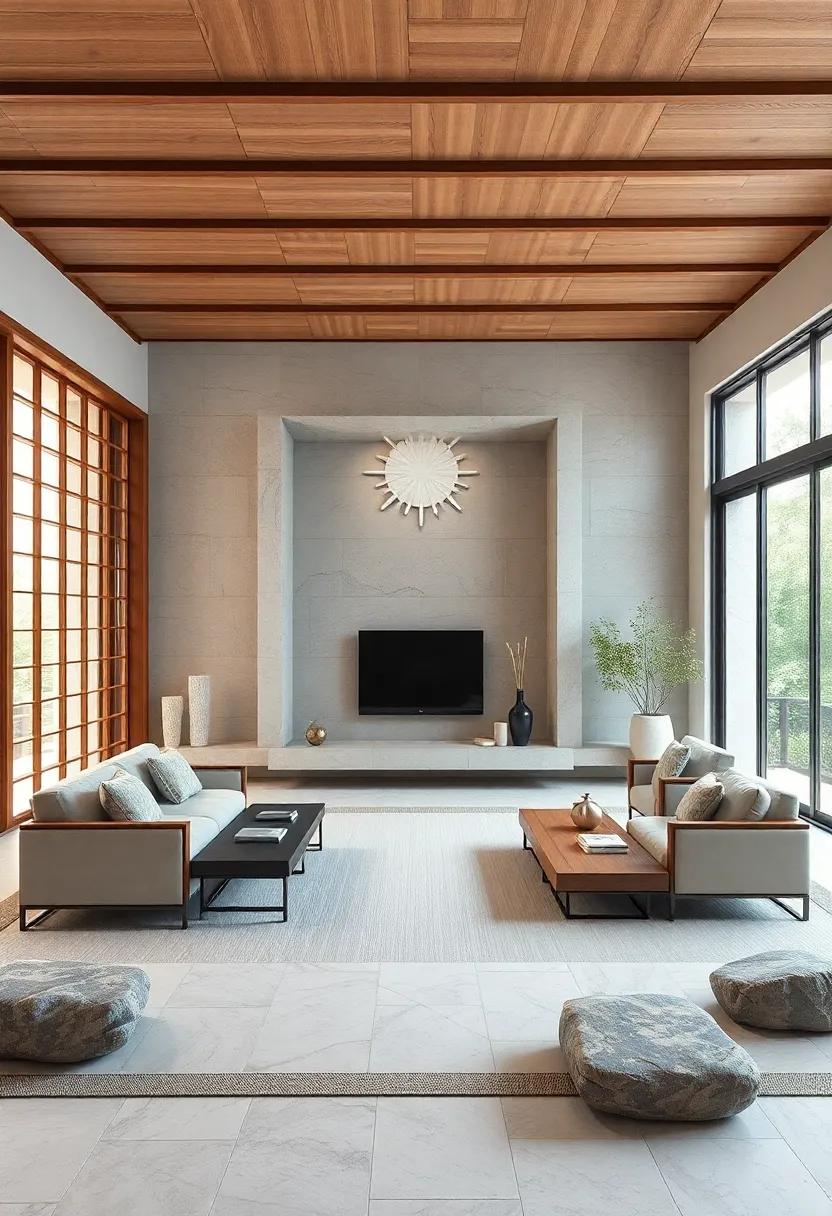
Creating a serene living space in a Japanese home involves a thoughtful arrangement of both furniture and decor elements, and the inclusion of natural stone can play a pivotal role in this balance. Strategic stone placement can enhance the room’s energy flow, allowing for a seamless blend of aesthetics and functionality. Incorporating stones such as granite, slate, and river stones can foster a grounding atmosphere.Consider these placement techniques:
- Accent Walls: Use stone tiles as a backdrop behind seating areas to create a focal point.
- Floor Features: Employ stone flooring or embedded stones in wooden flooring for an organic touch.
- Artistic Displays: arrange stones in decorative bowls or art installations to connect with nature.
Moreover, the strategic use of stone can direct movement and enhance the spatial dynamics of the room. Such as, placing a smooth pebble pathway leading to a zen garden not only invites tranquility but also encourages mindfulness. The interplay of light and shadow created by stones can dramatically alter the perception of space, giving the impression of a larger, more open environment. To visualize these concepts further, consider the following table showcasing common stones and their ideal placements:
| Stone Type | Ideal Placement | Design Benefit |
|---|---|---|
| Granite | Countertops & Accent Walls | Durability & sophistication |
| Slate | Floors & Backsplashes | Textured Elegance |
| River Stones | Zen Gardens & Decorative Bowls | Natural Calmness |
Timeless Elegance: The Endurance of Natural Stone in Design Trends
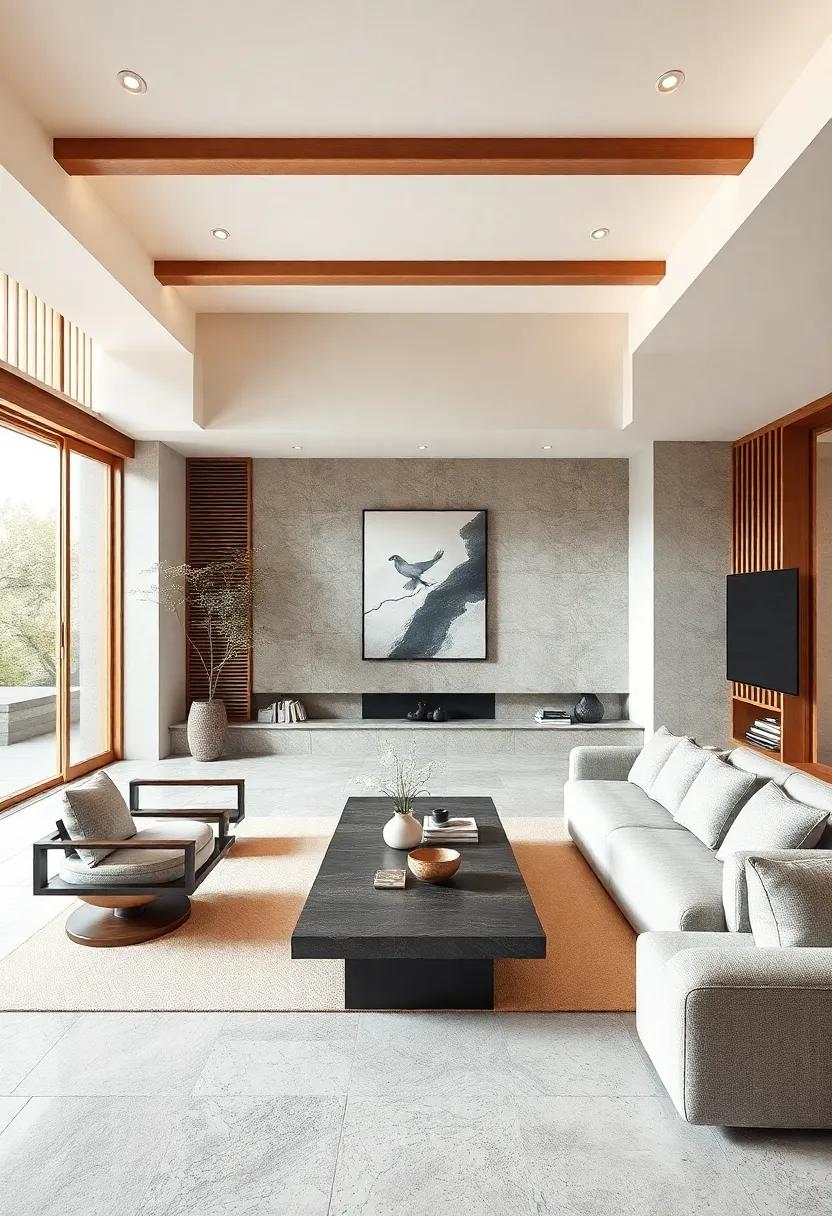
Natural stone has an unparalleled ability to infuse spaces with a sense of authenticity and enduring beauty, captivating designers and homeowners alike. In the context of Japanese living rooms, this elegant material harmonizes effortlessly with traditional aesthetics and modern sensibilities.Whether through tatami mats paired with stone benches or distinctive hearths crafted from granite, the versatility of stone allows for practical yet artistically rich elements that celebrate craftsmanship and nature.
Incorporating natural stone into design can manifest in various forms, enhancing tactile experiences and visual appeal. Some popular applications include:
- Accent Walls: A stunning backdrop that draws the eye and creates a striking focal point.
- Textured Flooring: Adding warmth and earthy tones that complement minimalistic furniture.
- Artisan Sculptures: Unique pieces of art that serve as conversation starters while connecting to nature.
Moreover, the longevity of natural stone ensures that these design choices withstand the test of time, making them not only beatiful but also a wise investment for future generations.
Visual Cohesion: Achieving Uniformity with Various Stone Types
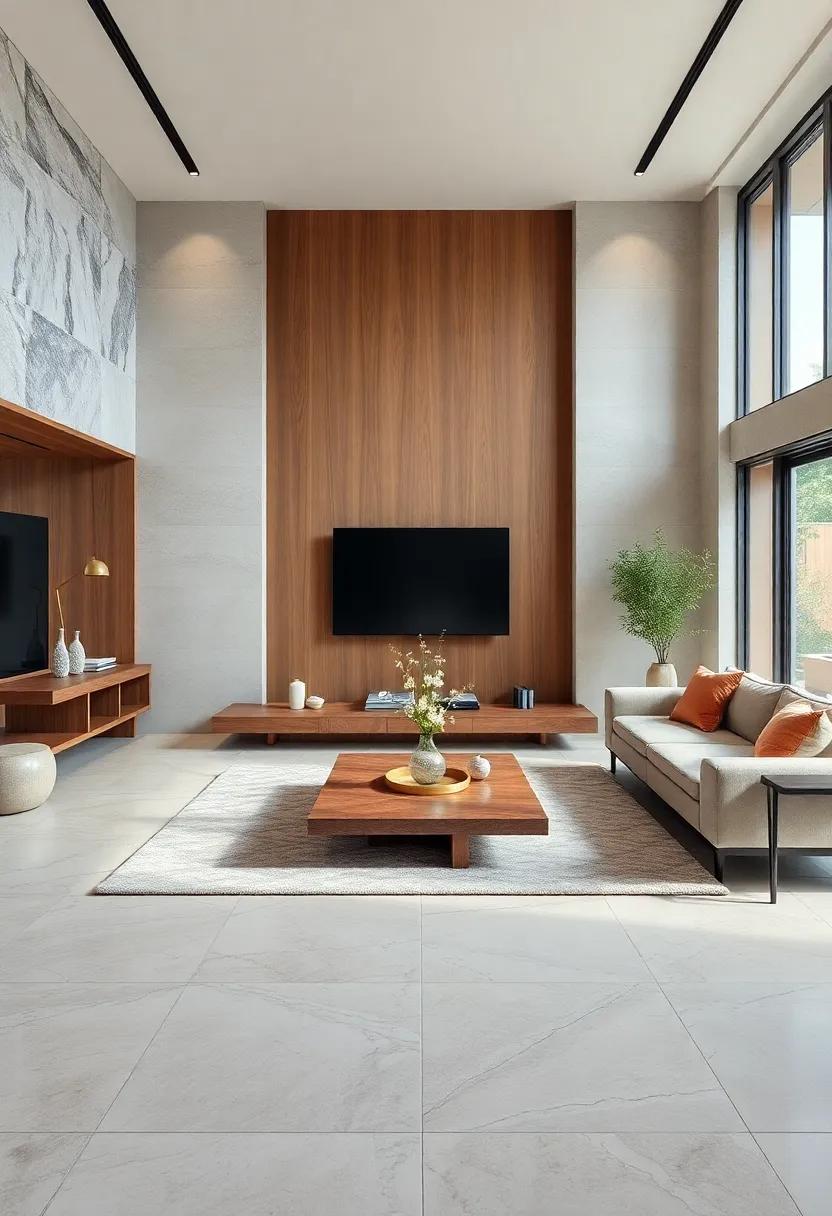
Incorporating various stone types into a single design can create a striking visual coherence, blending natural textures and colors that evoke serenity and balance. When selecting stones such as granite, marble, and slate for a Japanese living room, it’s essential to focus on their inherent qualities while harmonizing their differences. Aim for a palette that highlights the natural variations in tones and patterns, allowing each stone to contribute uniquely to the overall aesthetic. Consider using a variety of finishes, from polished to rustic, to enhance the tactile experience while maintaining an inviting atmosphere.
To achieve a unified look, it’s beneficial to strategically group stone elements. Here are a few tips to guide your selection:
- Color Matching: Choose stones that share similar hues; for example, warm earth tones can seamlessly blend when contrasted with subtler shades.
- Pattern Variation: Use the natural veining or speckling of stones to your advantage, creating a rhythm throughout the space.
- Surface texture: Mix smoother stones with more textured options to add depth and interest without overwhelming the senses.
In determining which stones to feature, consider their properties and how they contribute to the ambiance. Below is a simple comparison table highlighting the key features of popular stone types suitable for Japanese interiors:
| Stone Type | Color palette | Finish Options |
|---|---|---|
| granite | Earthy tones | Polished, honed |
| Marble | White, cream, gray | Polished, matte |
| Slate | Dark gray, green | Textured, smooth |
by thoughtfully curating different stone types, one can create an elegant fusion that pays homage to nature while ensuring a cohesive design throughout the living space.
Cohesive Storytelling: Telling Your Design Journey through Stone Elements

In the heart of japanese living spaces, the elegant interplay of stone elements weaves a narrative that transcends mere aesthetics. Using natural stones like granite, slate, and river rocks, designers craft environments that resonate with the tranquility of nature. Each stone tells a story—a story of geological history, cultural significance, and harmonizing with simplicity. This intentional use of stone in design not only enhances the sensory experience but fosters a deeper connection with the surroundings, evoking feelings of peace and balance.
Incorporating stone elements into the living room transforms common spaces into sanctuaries of calm. Consider the following ideas to harmonize stone within your design journey:
- Feature Walls: Create an accent wall using natural stone to serve as a centerpiece that draws the eye.
- Table surfaces: Choose a coffee table with a stone top to introduce tactile contrasts against softer furnishings.
- Accessorizing with pebbles: Utilize pebbles in decorative vases or as part of a centerpiece to bring the outdoors in.
- Stone Pathways: Integrate stone pathways within an indoor garden to guide visitors through serene spaces.
These elements weave together to create a cohesive narrative that honors the tradition of Japanese aesthetics. The careful selection and placement of stone can enhance the overall ambiance, making the living room a reflection of both personal aesthetic and cultural appreciation. As you embark on this journey, remember that every stone should be chosen not just for its beauty, but for the story it brings into your home.
Seasonal Adaptations: Designing With Stone Throughout the Year

In the vibrant tapestry of Japanese design, stone elements shift gracefully with the seasons, echoing the natural rhythms of the environment. Each season brings its unique palette, inviting materials to transform living spaces into serene sanctuaries. During spring, soft pastel hues of cherry blossoms inspire the incorporation of pale stones like igneous granite, which blends seamlessly with natural wood tones. As summer arrives, the focus shifts to cooler materials; smooth river stones in shades of grey and blue can evoke calmness, creating a refreshing vibe perfect for warm afternoons.
The transition into autumn can be reflected in the warm, earthy tones of sandstone, accentuating the rich colors of changing leaves. This season serves as an ideal backdrop for the use of textured stone elements,providing warmth and inviting cozy gatherings. As winter sets in, consider the incorporation of dark, polished slate or even rugged basalt to echo the stark beauty of frosted landscapes, creating an inviting atmosphere for indoor retreats.with each change, the adaptability of stone facilitates a harmonious balance between the interior space and the seasonal world outside.
Emotional Resonance: Evoking Feelings with Natural Stone Elements

Natural stone elements infuse a space with a sense of authenticity and grounding that resonates deeply with the human spirit. Incorporating materials like granite, marble, and slate brings the raw beauty of nature into the heart of Japanese living rooms, creating an environment that not only captivates visually but also evokes a myriad of emotions. Each stone tells a story of its formation, weathering, and history, establishing a timeless connection between the occupants and the earth itself. The tactile experience of these surfaces—smooth marble countertops,rough slate tiles,and the coolness of polished stone—encourages a moment of mindfulness,inviting individuals to pause and embrace their surroundings.
To harness the emotional power of natural stones,consider the following elements that can seamlessly integrate into a Japanese aesthetic:
- Accent walls: Use large stone slabs to create a stunning focal point that draws the eye.
- Fireplaces: Incorporate a stone feature that warms both the space and the heart.
- Tabletops: Select a unique stone for your living room tables to initiate conversations and reflections.
These elements not only serve functional purposes but also enhance the overall ambiance, transforming the living space into a sanctuary of tranquility. As you develop your design, remember that less is frequently enough more; letting the stone stand out in its natural form can evoke feelings of peace and serenity, synonymous with the essence of Japanese design.
Artistic Arrangements: Creative Ways to Display Natural Stone Features

Natural stone features can be a stunning focal point in any Japanese living room, enhancing the serene and minimalist aesthetic typical of this design style. To maximize their visual impact, consider creating an artistic arrangement that incorporates various elements of nature into your display. Here are some creative ideas:
- layering Textures: Combine smooth stones with weathered driftwood to create a contrast that reflects the harmony of nature.
- Incorporating Greenery: Use potted plants to soften the hard surfaces of stone, introducing vibrant colors and life.
- Natural Lighting: Position stones near windows to catch the sunlight, creating dynamic shadows that change throughout the day.
For those looking to take their displays to the next level, consider creating a dedicated stone feature wall. This could be achieved with an elegant arrangement of slate or granite tiles, artfully arranged to emphasize their natural patterns. To complement this, you might want to utilize a simple table like the one below to highlight your preferences:
| Stone Type | Use Case |
|---|---|
| Granite | Countertops or Decorative Slabs |
| Slate | Accent Walls or Smokey Fireplaces |
| river Pebbles | Indoor Water Features or Planters |
Functional Beauty: Merging Purpose and aesthetics in Design Choices
Incorporating natural stone accents into Japanese living room designs not only elevates the aesthetics but also enhances the functional aspects of the space. The use of stone creates a seamless connection between indoor environments and the tranquility of nature, which is a basic principle of traditional Japanese design. Elements like stone feature walls or carefully placed stone sculptures can serve as focal points, enriching the room’s ambiance while promoting a sense of calm. Benefits of integrating natural stone include:
- Durability: Stone is incredibly resilient and withstands the test of time.
- Thermal Regulation: Natural stone can help maintain a cozy temperature in the living space.
- Sound Absorption: Stone materials can dampen sound, fostering a serene atmosphere.
Moreover, the textural diversity of stone can complement various other materials, such as wood or fabrics, creating a harmonious balance that enhances the overall sensory experience of the living room. Using softer finishes alongside the robustness of stone can evoke a feeling of warmth and welcome. Considerations for selecting the right stone accents include:
| Stone Type | Suitability | Style Impact |
|---|---|---|
| Granite | High durability, ideal for surfaces | Modern elegance |
| Slate | Textured and slip-resistant | Rustic charm |
| Marble | Sophisticated and stylish | Classic luxury |
Inviting nature Indoors: Creating a Connection with the Outside World
Bringing the serene essence of the outdoors into your home can foster a peaceful atmosphere and create a desired balance between nature and design. One of the best ways to achieve this is by incorporating natural stone accents into Japanese living rooms. These elements not only enhance the aesthetic appeal but also establish a tactile connection to the earth. Using materials such as granite, marble, or slate can provide a grounding effect, inviting a sense of calmness and tranquility that mirrors the beauty of nature. Encourage your senses to engage with the textures and colors of these stones, which can be harmoniously integrated into various aspects of your living space, such as flooring, walls, or decorative features.
To maximize this connection with nature, consider the following ways to incorporate natural stone accents in your interior design:
- Feature Walls: Utilize large stone slabs to create a stunning focal point, drawing the eye and enhancing the natural ambiance.
- Hearth and Surrounds: A stone fireplace can become the heart of your home, radiating warmth and inviting comfort.
- Tabletops: Use stone surfaces for coffee tables or side tables to add elegance and durability.
- Decorative Accessories: Incorporate smaller stone accents such as coasters, vases, or sculptures to subtly enhance the connection with the outdoors.
Calming Contours: The Softness of Stone Accents in Relaxation Areas
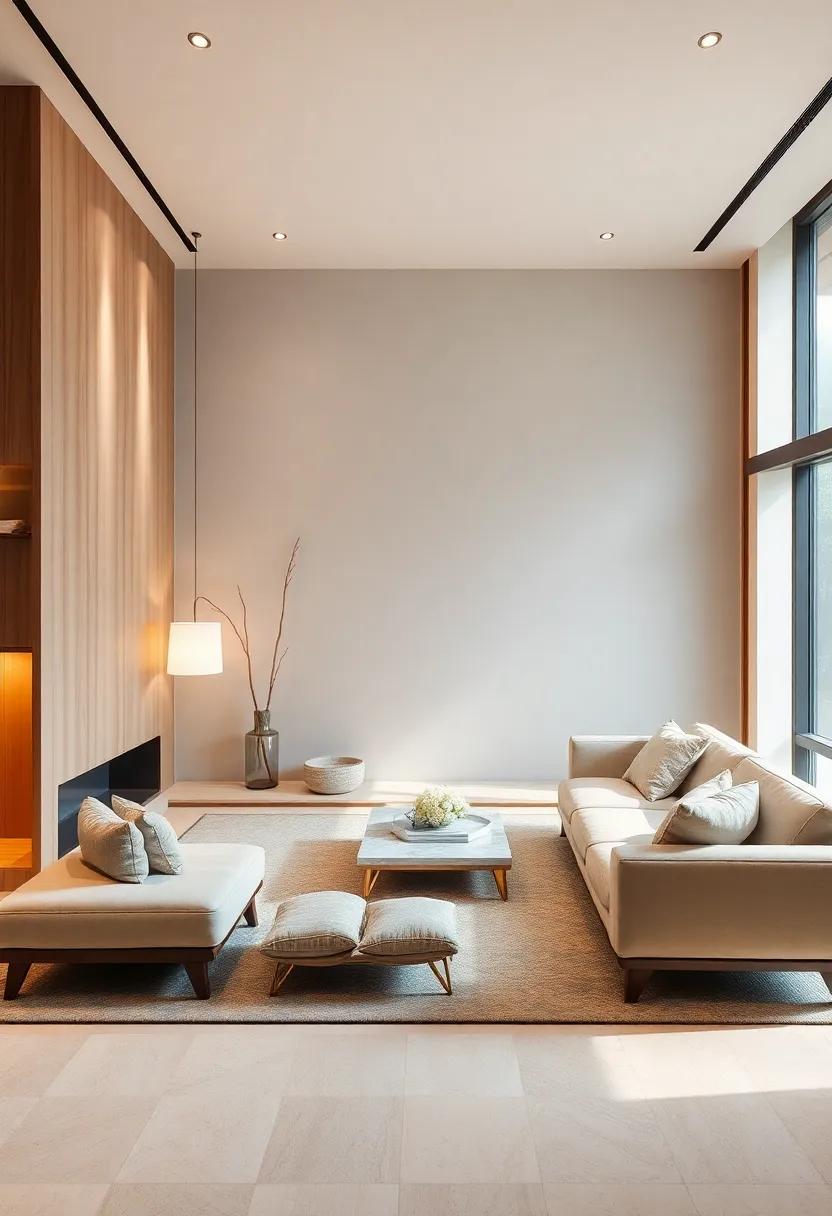
Incorporating stone accents into relaxation areas significantly enhances the sensory experience, allowing the natural world to permeate the home’s interior. The innate softness of stone adds a tactile dimension, fostering tranquility and grounding the space.Elements such as smooth pebbles and slate tiles can seamlessly blend with traditional tatami mats or minimalist furniture, creating a harmonious atmosphere that invites rest and contemplation. The organic shapes and earthy tones of these materials evoke a calming presence,encouraging moments of serenity within busy lives.
Consider these delightful features when designing your relaxation area:
- Natural Stone Benches: Perfect for meditation spots, fostering a direct connection with nature.
- Textured Accent Walls: Using stone cladding to introduce visual and tactile warmth.
- Flowing Water Features: Combining stone with water elements for soothing soundscapes.
To further illustrate the potential of stone elements, the following table outlines popular stone choices along with their unique attributes:
| Stone Type | Attributes |
|---|---|
| Granite | Durable and elegant, ideal for countertops or decorative features. |
| Marble | Luxurious feel, perfect for statement pieces. |
| Slate | Natural slip resistance, suitable for flooring. |
| basalt | Dark,earthy tones,great for outdoor and indoor contrasts. |
Life in Detail: Emphasizing Craft and Care using Stone Décor
In the realm of Japanese living rooms,the charm of stone décor lies not just in aesthetics,but in the meticulous craftsmanship that goes into each piece. Natural stones,whether it’s a striking granite coffee table or a textured slate feature wall,embody a raw elegance that ties the space to nature. The soothing colors and patterns found in these materials can create an atmosphere that promotes mindfulness and tranquility. A few key elements that enhance this design philosophy include:
- Natural textures: Emphasizing rich, tactile surfaces that invite touch and interaction.
- color Harmony: Selecting stones that harmonize with soft, earthy tones typical of minimalist Japanese interiors.
- Functional Art: Choosing décor pieces that serve practical purposes while being aesthetically pleasing.
Integrating stone accents into Japanese living spaces encourages an appreciation for nature’s artistry and the subtleties of craftsmanship. consider the use of slab benches or stone planters to create eye-catching focal points that also offer utility. Below is a simple overview of various stone types and their ideal applications in modern Japanese décor:
| Stone Type | Application |
|---|---|
| Granite | Countertops, tables |
| slate | Wall coverings, flooring |
| limestone | Feature walls, sculptures |
| River Rock | Garden paths, water features |
Cultural Conversations: How Stone Reflects Local Traditions and History
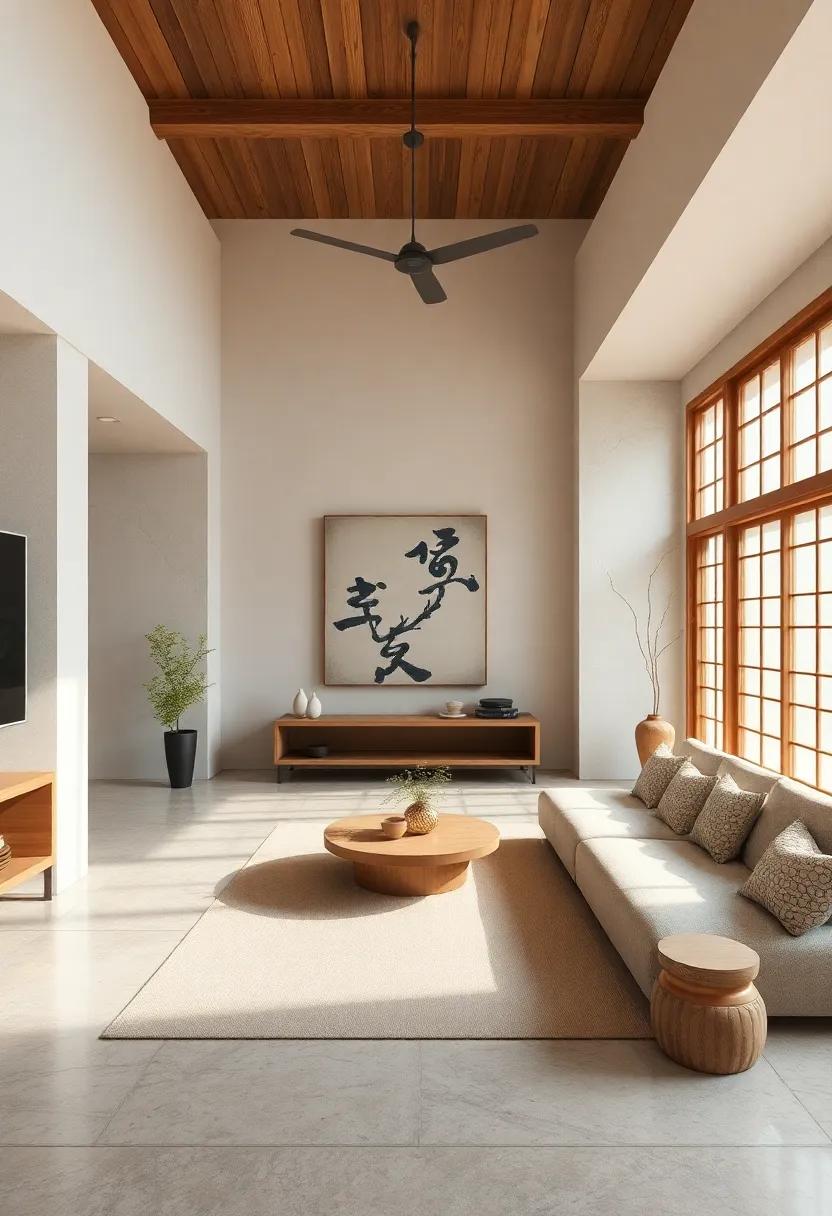
Natural stone has long been revered in Japanese culture, serving not only as a building material but also as a medium for artistic expression. Each stone tells a story, reflecting the region it hails from and the traditions of the people who cherished it. In Japanese living rooms, these accents embody a deep-rooted connection to nature through their tactile quality and varied textures. The use of stones like granite, slate, and limestone can evoke feelings of tranquility, bridging the indoors with the serene landscapes outside. This philosophy is part of a broader aesthetic that values simplicity and harmony, where every element has a purpose and is a tribute to the natural world.
Additionally, the incorporation of stone into interior design can also serve to foster cultural continuity. In many cases, traditional practices such as tatami mat placement alongside stone features create a balanced environment that resonates with history. The significance of a carefully selected stone extends beyond its physical form; it can signify prosperity, wisdom, and resilience, virtues deeply embedded in Japanese society. A well-designed living room using stone can manifest a microcosm of local traditions, connecting current generations with their heritage. People have used stones for artistic purposes in various forms:
- Garden pathways distinctively lined with smooth river stones.
- Accent walls showcasing unique textures that narrate local geology.
- Fireplaces built from local stones symbolizing warmth and unity.
The Conclusion
As we conclude our exploration of harmony in design through the use of natural stone accents in Japanese living rooms, it becomes evident that these elements do more than merely embellish a space—they weave a deeper narrative of tranquility and connection to nature. By embracing the timeless appeal of stone, we invite a sense of grounding and balance that resonates with the core principles of Japanese aesthetics. Whether it’s a modest stone feature or an elaborate arrangement, each piece plays a pivotal role in transforming a living room into a sanctuary of calm and inspiration.
in a world that frequently enough encourages a fast-paced lifestyle, infusing our homes with the serenity of natural elements offers us a retreat from the chaos. As you consider your own space, let the allure of stone guide your choices—celebrating imperfection, honoring nature, and creating a living environment that reflects both beauty and mindfulness. The journey does not end here; rather, it begins anew each time you step into a thoughtfully designed room, enveloped by the harmonious whispers of nature.
As an Amazon Associate I earn from qualifying purchases.

